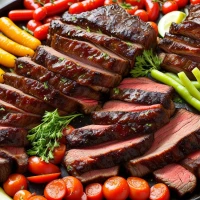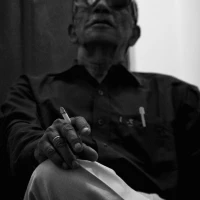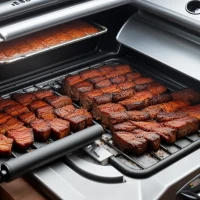Barbecue enthusiasts and culinary aficionados, the path to achieving that perfectly tender and flavorful brisket doesn’t end at the smoker or grill. The secret lies not only in the cooking process but also in the essential resting stage that follows. If you’ve ever been tempted to slice right into a steaming hot brisket, you may have unwittingly sacrificed the lusciousness that could have been. In this comprehensive guide, we will unlock the mystery behind the optimal resting time for brisket, ensuring that every bite is just as succulent and delicious as you’ve dreamed.
Indulging in the slow-cooked delight of brisket becomes an experience to savor when done correctly. Many pitmasters agree that the resting phase allows the juices to redistribute, which is crucial for a juicier brisket. But how long to let brisket rest? Is there such a thing as too much resting? Whether you’re a seasoned pro or a curious novice, this article will provide the answers, unraveling the nuances of brisket preparation and guiding you towards the ultimate barbecue triumph.
The Essence of Brisket Resting: A Guide to Maximizing Flavor
Why Rest Your Brisket?
Before delving into the specifics, let’s understand why resting is non-negotiable in the journey of brisket perfection. When exposed to heat, the fibers in the brisket tighten, and juices are pushed towards the center. By allowing the meat to rest, you give these fibers time to relax and reabsorb the juices. This results in a brisket that is not only more tender but also retains moisture when sliced, rather than spilling it onto the cutting board.
The Science Behind the Rest
The internal temperature of your brisket continues to rise even after it is removed from heat, a phenomenon known as “carryover cooking.” Resting allows the temperature to even out, settling the juices back into the meat. Bypassing this step can lead to a dryer, tougher brisket, whereas a proper rest can enhance the texture and taste exponentially.
How Long Should You Let Your Brisket Rest?
The million-dollar question for brisket lovers is how long to let the brisket rest to achieve that coveted, juicy brisket experience. Here is where pitmasters diverge in their opinions, but a common consensus falls within a specific range.
Resting Time: The Sweet Spot
- Minimum Rest Time: 30 minutes
- Ideal Rest Time: 1 to 2 hours
- Extended Rest Time: Up to 4 hours (for large cuts)
While brisket might be forgiving in the smoker, it’s less so on the cutting board. Resting for too short a time will cause those valuable juices to escape, while resting for too long may result in a cold, less appealing brisket. Your goal is to hit the sweet spot where the brisket is warm, the juices are stabilized, and the fibers are as tender as possible.
Resting Temperature and Environment
Resting your brisket isn’t just about time; the environment plays a pivotal role. Many pitmasters advocate for the “faux Cambro” method, which involves wrapping the brisket in butcher paper or aluminum foil and then in towels, subsequently placing it in a cooler to maintain an optimal temperature. This setup mimics a Cambro, a tool often used by caterers to keep food warm during transport.
Factors to Consider:
- Room Temperature: Avoid drafts or cold surfaces which can cool the brisket too quickly.
- Insulation: Using towels and a cooler ensures heat retention without continuing to cook the meat.
- Monitoring: Keep an eye on the internal temperature; it should not dip below 140°F to ensure food safety.
Techniques for Resting Your Brisket
Achieving a juicy brisket doesn’t happen by chance. It’s a result of precise technique and attention to detail. Let’s explore several methods you can employ to optimize the resting stage.
Wrapping: To Wrap or Not to Wrap?
- Butcher Paper: Breathable and allows excess steam to escape while still retaining heat.
- Aluminum Foil: Provides a tighter seal but may result in a softer bark due to trapped moisture.
- Unwrapped: Riskier, as the meat may cool too quickly, but preserves the bark’s integrity.
Resting Containers: Faux Cambro vs. Oven
- Faux Cambro: Using a cooler insulated with towels is cost-effective and portable.
- Oven: Setting the oven to a low temperature like 150°F to 170°F can keep the brisket warm if you lack a cooler.
Slicing and Serving: The Final Steps
Once rested, it’s time to slice your brisket. Use a sharp knife and slice against the grain for maximum tenderness. The thickness of the slices can vary according to preference, but generally, it’s best to aim for about 1/4-inch thick slices for the perfect texture.
Tips for Slicing:
- Sharpen Your Knife: A dull knife can shred the meat and ruin the texture you’ve worked so hard for.
- Avoid Sawing: Use smooth, confident strokes to slice through the brisket.
- Mind the Grain: Identify the direction of the muscle fibers and cut perpendicular to them.
Troubleshooting: Common Brisket Resting Pitfalls
Even with the best intentions, sometimes things go awry. Here’s how to tackle common issues related to resting brisket.
- Overcooling: If your brisket has cooled too much, gently reheat it in a low-temperature oven.
- Overcooking: If the internal temperature rises too much during the rest, remove the brisket from its insulated environment to slow the process.
Conclusion: Patience Pays in Brisket Perfection
Unlocking the secret to juicier brisket lies in understanding and respecting the resting phase. A balanced combination of time, temperature, and technique will result in a brisket that cuts like butter and pleases the palate. Remember, brisket is more than just a meal—it’s a craft, and the rest is an art form within that craft. With the tips outlined in this guide, you’re now equipped to ascend to new heights in barbecue mastery.
Embracing the patience required during the resting period is what separates the amateur from the aficionado. So the next time you fire up the smoker, remember that the journey to brisket glory doesn’t end there. When you’ve cooked your cut to perfection, give it the rest it deserves, and you’ll surely reap the rewards on the plate.










